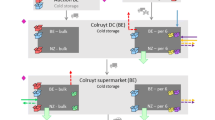Abstract
Goal, Scope and Background
The issue of whether food miles are a relevant indicator for the environmental impacts associated with foods has received significant attention in recent years. It is suggested here that issues other than the distance travelled need to be considered. The argument is presented by illustrating the case for the provision of apples.
Materials and Methods
The effects of variability in primary energy requirements for apple cultivation and for other life cycle stages, seasonality (timing of consumption) and loss of produce during storage are studied in this paper, by comparing apples from different supplier countries for consumption in Europe.
Results
Data sources for primary energy use (PEU) of apple production are identified ranging from 0.4–3.8 MJ/kg apples for European and Southern American countries and 0.4–0.7 MJ/kg for New Zealand. This variability is related to different yields and producer management practices in the different countries. Storage loss may range from 5% to 40% for storage periods between 4 and 10 months, and this has a significant effect on the results (e.g. increasing the total PEU by 8–16% when stored for 5–9 months in Europe as compared with a no loss and no storage situation). The storage periods and related storage losses change markedly through the year for imported (i.e. non-European) versus European apples.
Discussion
The timing of consumption and related storage losses need to be included in the assessment, as this affects the order of preference for locally sourced versus imported apples. The variability in energy requirements in different life cycle stages, but particularly for the fruit production stage, is also significant in this comparative analysis.
Conclusions
Overall, it seems that there are similarities in the total PEU ranges for European and New Zealand apples during the Southern Hemisphere’s apple season (European spring and summer). However, during the European autumn and winter (Northern Hemisphere apple season) PEU values are generally higher for apples imported from the Southern Hemisphere compared with European apples consumed in Europe. However, this latter observation may not hold true where apples for consumption in one European country are imported from another European country, because energy use for road transportation has a significant influence on the result.
Recommendations and Perspectives
Future studies comparing alternative sources of fresh produce need to account for ranges of data for the fruit production and storage stages, which reflect the seasonality of production.
Similar content being viewed by others
References
Smith A, Watkiss P, Tweddle G, McKinnon A, Browne M, Hunt A, Treleven C, Nash C, Cross S (2005): The validity of food miles as an indicator of sustainable development. ED50254, 103. Oxon, UK, Defra
Schlich EH, Fleissner U (2005): The ecology of scale: Assessment of regional energy turnover and comparison with global food. Int J LCA 10(3) 219–223
Jungbluth N, Demmeler M (2005): ’The ecology of scale: Assessment of regional energy turnover and comparison with global food’ by Elmar Schlich and Ulla Fleissner. Int J LCA 10(3) 168–170
Sim S, Barry M, Clift R, Cowell SJ (in press): The relative importance of transport in determining an appropriate sustainability strategy for food sourcing. A case study of fresh produce supply chains. Int J LCA 2006 (OnlineFirst): DOI: http://dx.doi.org/10.1065/lca2006.07.259
Blanke MM, Burdick B (2005): Food (miles) for thought. Energy balance for locally-grown versus imported apple fruit. Env Sci Pollut Res 12(3) 125–127
Huijbregts MAJ, Rombouts LJA, Hellweg S, Frischkmecht R, Hendriks AJ, van de Meent D, Ragas AMJ, Reijnders L, Struijs J (2006): Is cumulative fossil energy demand a useful indicator for the environmental performance of products? Environ Sci Technol 40(3) 641–648
Milà i Canals L (2003): Contributions to LCA Methodology for Agricultural Systems. Site-dependency and soil degradation impact assessment. PhD Thesis. Universitat Autònoma de Barcelona, Spain. Available at 〈http://www.tdx.cesca.es/TDX-1222103-154811/〉
Milà i Canals L, Burnip GM, Cowell SJ (2006): Evaluation of the environmental impacts of apple production using Life Cycle Assessment (LCA): Case study in New Zealand. Agriculture, Ecosystems and Environment 114, 226–238
Sim S (2006): Sustainable Food Supply Chains. EagD portfolio. University of Surrey, UK
Stadig M (1997): Life cycle assessment of apple production: Case studies for Sweden, New Zealand and France. SIK Report No. 630, p 117. Gothenburg, Sweden (in Swedish, summary in English)
Reganold JP, Glover JD, Andrews PK, Hinman HR (2001): Sustainability of three apple production systems. Nature 410, 926–930
Mouron P, Nemecek T, Scholz RW, Weber O (2006): Management influence on environmental impacts in an apple production system on Swiss fruit farms: Combining life cycle assessment with statistical risk assessment. Agriculture, Ecosystems and Environment 114, 311–322
Mason R, Simons D, Peckham C, Wakeman T (2002): Life cycle modelling CO2 emissions for lettuce, apples and cherries. FSP, EAFL, UK, 84 pp
Morgan MG, Henrion M (1990): A Guide to dealing with uncertainty in quantitative risk and policy analysis. Cambridge University Press, New York
Royal Commission on Environmental Pollution (2002): The environmental effects of civil aircraft in flight — Special report. Royal Commission on Environmental Pollution, UK
MacGregor J, Vorley B (2006): Fair Miles? The concept of ‘food miles’ through a sustainable development lens. IIED. London, UK
FAOSTAT data (2005): 〈http://faostat.fao.org/faostat/〉, last accessed August 2005
Hischier R (2004): Life cycle inventories of packagings and graphical papers. ecoinvent-Report No. 11, Swiss Centre for Life Cycle Inventories, Dübendorf, 2004
Sonesson U, Janestad H, Raaholt B (2003): Energy for preparation and string of food — Models for calculation of energy use for cooking and cold storage in households. SIK-Rapport Nr 709 2003
Author information
Authors and Affiliations
Corresponding author
Rights and permissions
About this article
Cite this article
Milà i Canals, L., Cowell, S.J., Sim, S. et al. Comparing domestic versus imported apples: A focus on energy use. Env Sci Poll Res Int 14, 338–344 (2007). https://doi.org/10.1065/espr2007.04.412
Received:
Accepted:
Published:
Issue Date:
DOI: https://doi.org/10.1065/espr2007.04.412



